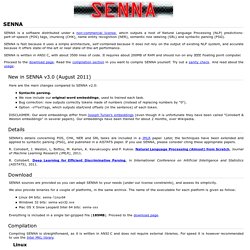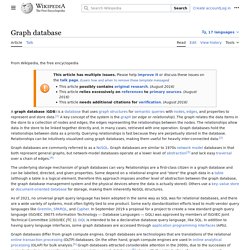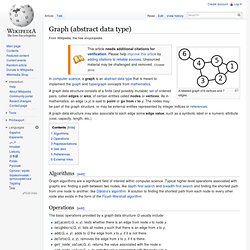

Semantic Networks. John F.

Sowa This is an updated version of an article in the Encyclopedia of Artificial Intelligence, edited by Stuart C. Shapiro, Wiley, 1987, second edition, 1992. Most of the text from 1992 is unchanged, but more references and updates have been added. A semantic network or net is a graph structure for representing knowledge in patterns of interconnected nodes and arcs. What is common to all semantic networks is a declarative graphic representation that can be used to represent knowledge and support automated systems for reasoning about the knowledge. Definitional networks emphasize the subtype or is-a relation between a concept type and a newly defined subtype. Network notations and linear notations are capable of expressing equivalent information. 1. The oldest known semantic network was drawn in the 3rd century AD by the Greek philosopher Porphyry in his commentary on Aristotle’s categories.
Figure 1. Figure 2. Every truck is a vehicle. Figure 3. SENNA. SENNA is a software distributed under a non-commercial license, which outputs a host of Natural Language Processing (NLP) predictions: part-of-speech (POS) tags, chunking (CHK), name entity recognition (NER), semantic role labeling (SRL) and syntactic parsing (PSG).

SENNA is fast because it uses a simple architecture, self-contained because it does not rely on the output of existing NLP system, and accurate because it offers state-of-the-art or near state-of-the-art performance. SENNA is written in ANSI C, with about 3500 lines of code. It requires about 200MB of RAM and should run on any IEEE floating point computer. Proceed to the download page.
Read the compilation section in you want to compile SENNA yourself. New in SENNA v3.0 (August 2011) Here are the main changes compared to SENNA v2.0: DISCLAIMER: Our word embeddings differ from Joseph Turian's embeddings (even though it is unfortunate they have been called "Collobert & Weston embeddings" in several papers).
Details. Concept extraction. Graph database. Graph databases are part of the NoSQL databases created to address the limitations of the existing relational databases.

While the graph model explicitly lays out the dependencies between nodes of data, the relational model and other NoSQL database models link the data by implicit connections. Graph databases, by design, allow simple and fast retrieval[citation needed] of complex hierarchical structures that are difficult to model[according to whom?] In relational systems. Graph databases are similar to 1970s network model databases in that both represent general graphs, but network-model databases operate at a lower level of abstraction[3] and lack easy traversal over a chain of edges.[4] Graph databases differ from graph compute engines.
Background Graph databases, on the other hand, portrays the data as it is viewed conceptually. Graph Graph databases employ nodes, properties, and edges. A graph within graph databases is based on graph theory. GraphBase - the World's Most Powerful Graph DBMS. Graph (abstract data type) A labeled graph of 6 vertices and 7 edges.

A graph data structure may also associate to each edge some edge value, such as a symbolic label or a numeric attribute (cost, capacity, length, etc.). Graph algorithms are a significant field of interest within computer science. Typical higher-level operations associated with graphs are: finding a path between two nodes, like depth-first search and breadth-first search and finding the shortest path from one node to another, like Dijkstra's algorithm.
A solution to finding the shortest path from each node to every other node also exists in the form of the Floyd–Warshall algorithm. The basic operations provided by a graph data structure G usually include: Structures that associate values to the edges usually also provide: get_edge_value(G, x, y): returns the value associated to the edge (x,y).set_edge_value(G, x, y, v): sets the value associated to the edge (x,y) to v. Different data structures for the representation of graphs are used in practice: Processing.js. Tutorials.